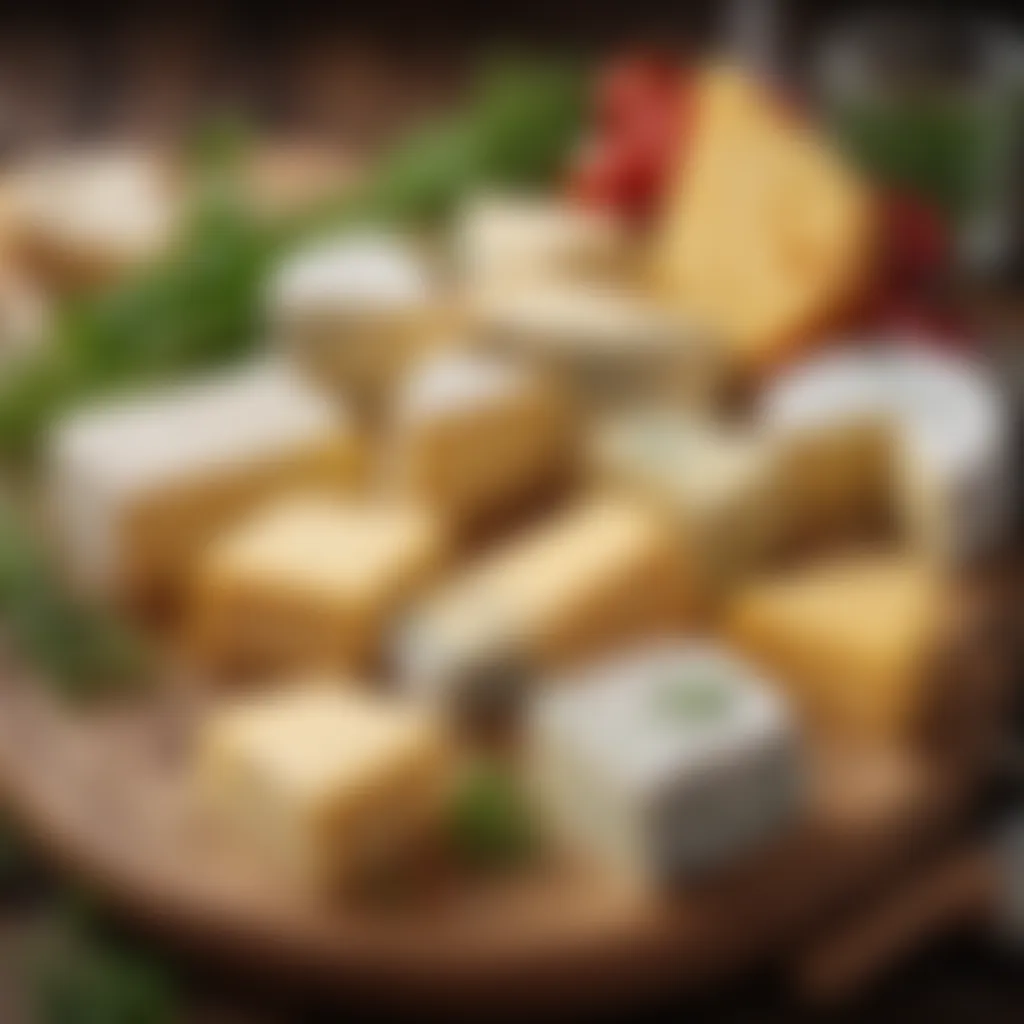Exploring Non-Aged Cheese: Unique Varieties & Uses


Intro
Non-aged cheese, often overlooked in culinary discussions, presents a refreshing alternative to its aged counterparts. Understanding the characteristics of non-aged cheese is essential for those who appreciate diverse taste profiles and textures. This article will discuss its unique attributes, various types, and its role in modern cooking, bringing non-aged cheeses into the spotlight.
The journey begins with an examination of what defines non-aged cheese, contrasting it with aged varieties. Unlike aged cheese, non-aged cheese, also known as fresh cheese, has not undergone the long maturation process. This lack of aging results in a creamier texture, milder flavor, and enhanced versatility in cooking.
As we explore this category, we will highlight various non-aged cheeses, their culinary applications, and the techniques that bring out their best flavors. Through this exploration, we hope to inspire greater appreciation for non-aged cheese in everyday cooking.
Understanding Non-Aged Cheese
Non-aged cheese is an often overlooked segment of the cheese universe, yet it plays a significant role in culinary practices and nutrition. Understanding non-aged cheese is vital for both home cooks and food enthusiasts because it presents a different set of flavors, textures, and uses than its aged counterparts. This exploration can enrich the dining experience and broaden the palate, allowing for creative culinary applications that highlight freshness.
Non-aged cheeses include a variety of types, each bringing something unique to the table. Recognizing these varieties is essential for making informed choices in recipes and pairings. By delving into the characteristics and uses, consumers can elevate their meals while embracing healthier options. Furthermore, understanding the production processes associated with non-aged cheese can also enlighten consumers about the freshness and health benefits that these cheeses can offer.
Definition and Characteristics
Non-aged cheese is defined as cheese that has not undergone the aging process. This type of cheese is typically fresh, soft, and moist. Some key characteristics include a mild flavor, soft texture, and a shorter shelf life. They are often made from whole milk, and they can present a wide range of uses in various culinary contexts.
Common examples include fresh mozzarella, ricotta, and feta. They are known for their versatility, making them suitable for salads, spreads, or even desserts. The absence of aging results in a clean, unprocessed taste that many consumers find appealing. Their ease of use in recipes is another benefit, as they can often be used directly from the package without additional preparation.
Distinction Between Aged and Non-Aged Cheese
The primary distinction between aged and non-aged cheese lies in the aging process. Aged cheese undergoes specific conditions over a period of time, developing complex flavors and textures. In contrast, non-aged cheese maintains its fresh, milky characteristics, as it is typically consumed shortly after production.
One of the apparent differences is in flavor. Non-aged cheeses usually have a delicate, light taste, often accompanied by a creamy mouthfeel. Aged cheeses, on the other hand, can have stronger, sharper flavors due to the breakdown of proteins and fats during the maturation phase.
In terms of texture, non-aged cheeses tend to be wetter and softer, while aged varieties can range from hard to semi-soft, with a variety of textures developed during the curing process.
Global Varieties of Non-Aged Cheese
Understanding the global varieties of non-aged cheese is essential to appreciate the rich diversity and culinary potential that exists in this category. Each type of non-aged cheese embodies unique characteristics, flavors, and textures influenced by local traditions and the specific ingredients used in their production. The exploration of these varieties allows one to engage with culinary applications that are versatile and flavorful, making them suitable for various dishes and occasions.
Moreover, these cheeses often carry nutritional benefits, proving to be lighter alternatives to aged cheeses while retaining desirable flavors. Home cooks can benefit from understanding the differences between these varieties to enhance their meals and accommodate diverse dietary preferences.
Fresh Cheese
Fresh cheese is commonly recognized for its mild and slightly tangy flavor. This type includes well-known varieties such as Ricotta, Cottage Cheese, and Cream Cheese. Typically characterized by a soft and crumbly texture, fresh cheese is made from unaged curds without the use of rennet, which contributes to its lightness. This cheese is often used in both savory and sweet dishes. Its high moisture content allows for creative culinary applications like spreads for bread, toppings for salads, or even in desserts like cheesecake.
Soft Cheese
Soft cheese, such as Brie or Camembert, presents a rich and creamy texture with a subtle earthy flavor. The production process for soft cheese often involves a different culturing technique, leading to a bloomy rind that is edible. These cheeses can elevate any cheese platter or serve as a luxurious addition to sandwiches and baked dishes. Their melting properties make them ideal for cooking, enhancing flavors in pasta or flatbreads.
Cream Cheese
Cream Cheese stands out within the realm of non-aged cheese due to its smooth, spreadable consistency. It's typically made from a blend of milk and cream, resulting in a delightful balance of richness and tanginess. Cream cheese is frequently used in frostings, dips, and spreads. Incorporating this cheese into culinary creations can add both texture and an enriching flavor profile, making it an essential component in many households.
Ricotta and Cottage Cheese
Both Ricotta and Cottage Cheese fall under the category of fresh cheese but cater to different tastes and textures. Ricotta is creamy and slightly sweet, making it a favorite in Italian dishes like lasagna and ravioli. It can also be used in desserts, creating a delicate balance in flavor. On the contrary, Cottage Cheese is chunkier with a more pronounced acidity, often enjoyed in salads or as a standalone snack. Both types offer versatility and nutritional advantages, with relatively lower fat content compared to aged cheeses.
Feta Cheese


Feta cheese is a brined curd cheese originating from Greece, characterized by its crumbly texture and savory, tangy flavor. It is made from sheep's milk or a mixture of sheep and goat milk. This cheese is commonly used in Mediterranean salads, pies, or as a topping on various dishes. Feta not only adds flavor but also provides a rich source of nutrients like calcium and vitamins. Its versatility allows it to be incorporated into both hot and cold dishes.
Mascarpone Cheese
Mascarpone is a velvety Italian cheese made from cream. Its rich, buttery consistency and sweet taste make it a favorite in desserts, especially in tiramisu. However, it can also be used in savory dishes, where it acts as a smooth and rich base for sauces. Its ability to enhance both sweet and savory flavors makes it a valuable ingredient in any kitchen.
Mozzarella and Burrata
Mozzarella and Burrata are types of fresh cheese with distinct profiles. Mozzarella is often celebrated for its elasticity and mild flavor, commonly used in pizzas and salads. Burrata, on the other hand, is a more decadent version, filled with creamy stracciatella and cream, making it richer than regular mozzarella. Both varieties contribute to a light yet satisfying culinary experience, often paired with fresh tomatoes or utilized in Italian dishes.
Understanding these varieties broadens one's culinary repertoire and enhances daily cooking experiences, allowing for diverse flavor profiles and textures in appealing dishes.
Production Processes for Non-Aged Cheese
The production processes for non-aged cheese are vital to understanding this unique food category. These steps influence not only the final product's taste and texture but also its nutritional value. By examining these processes, you can appreciate the craftsmanship behind your favorite non-aged cheeses. Moreover, each step plays a defining role in the overall quality and characteristics of the cheese.
Milk Selection
The choice of milk is fundamental in cheese-making. For non-aged cheeses, the source of milk can vary significantly. Cow's milk, goat's milk, and sheep's milk are common options. Each type brings distinct flavors and textures. For example, goat's milk often results in a slightly tangy flavor, while cow's milk produces a creamier profile. The quality of the milk is crucial; fresh, high-quality milk leads to superior cheese. In addition, the milk's composition, such as fat and protein levels, directly affects the coagulation process.
Coagulation Techniques
Coagulation involves the transformation of liquid milk into a solid curd. Different techniques can be employed here, primarily the use of rennet or acid. Rennet is an enzyme that facilitates curd formation by coagulating the milk proteins. Meanwhile, acidification occurs when lactic acid bacteria are introduced, leading to curd formation through acid. Each technique offers different characteristics to the resulting cheese. For instance, cheeses made with rennet tend to be firmer, while those using only acid would be softer and creamier.
Curd Treatment
After coagulation, the curd needs proper treatment. This step includes cutting, cooking, washing, or pressing the curds. Each treatment affects the moisture content and texture. Cutting involves slicing the curd into smaller pieces to release whey. Cooking can help in achieving the right texture; for instance, heating the curds further can lead to firmer textures. Washing the curd can also adjust the moisture level, which is crucial for softer cheeses like mozzarella or burrata. Each non-aged cheese has its specific curd treatment requirements, shaping its unique profile.
Packaging and Storage
Packaging and storage are essential to maintaining the quality of non-aged cheese. Proper packaging helps preserve moisture and flavor while preventing spoilage. Common methods include vacuum sealing and using airtight containers. Non-aged cheeses typically have a shorter shelf life compared to their aged counterparts. Therefore, understanding the storage conditions is crucial. Refrigeration is necessary and should ideally occur in a contained environment to avoid moisture loss. The method of packaging should allow for some airflow to prevent mold growth, a common issue with non-aged cheeses.
"The intricate production processes of non-aged cheese not only determine its taste and texture but also embody the art of cheese-making across cultures."
Sensory Attributes of Non-Aged Cheese
Understanding the sensory attributes of non-aged cheese is crucial for both culinary applications and appreciation of its uniqueness. These attributes encompass the texture, flavor, and aroma characteristics that make non-aged cheeses distinct. Each element contributes to the overall experience of consuming cheese, influencing how it is paired with other foods and enjoyed as part of a meal. The sensory attributes can enhance the flavors in dishes, marry well with wines, and provide complementary textures beyond the cheese itself.
Educating oneself about these sensory attributes empowers the home cook to create more engaging and harmonized meals. Knowledge of how to choose cheeses based on their sensory profiles can lead to informed decisions that not only elevate the dining experience but also tap into the rich potential of non-aged cheeses in various cuisines.
Texture and Mouthfeel
The texture and mouthfeel of non-aged cheese play significant roles in shaping the enjoyment of these products. Non-aged cheeses often exhibit a creamier and softer texture compared to their aged counterparts. For example, cheeses like mozzarella and ricotta provide a light, fluffy mouthfeel, which can enhance dishes like lasagna or fresh salads.
The higher moisture content in non-aged cheeses contributes to their smooth texture, allowing them to melt beautifully when heated or spread easily on bread or crackers. This quality makes them ideal for a variety of culinary applications, such as toppings for pizzas or mixed into pasta dishes.
"While texture can often be subjective, the delightful creaminess of non-aged cheese is universally appreciated."
Flavor Profiles
The flavor profiles of non-aged cheese vary considerably and can range from mild to bold. Fresh cheese varieties, like cream cheese, offer a delicate and slightly tangy taste, making them perfect for cheesecakes or as a base for dips. In contrast, feta cheese brings a sharp, briny flavor that complements Mediterranean salads and grain bowls.
The absence of aging generally results in a more subtle flavor, which can be advantageous when layering flavors in dishes. Non-aged cheeses can seamlessly blend with herbs and spices, providing a wonderful canvas for creativity in cooking. They can also serve as an excellent counterpoint to sweeter ingredients, enhancing the overall balance of a dish.


Aroma Characteristics
Aroma is another essential sensory attribute that significantly impacts the enjoyment of non-aged cheese. Each variety possesses unique aromatic qualities that can range from grassy and vegetal to nutty and creamy. For instance, fresh mozzarella has a milky, pleasant aroma, which is appealing and refreshing.
The aroma is often the first thing a person notices when encountering cheese, setting the stage for the tasting experience. Using non-aged cheese in dishes can change the fragrance profile of a meal, often making it more inviting. Adding these cheeses to a recipe may boost its aroma, drawing in diners by appealing to olfactory senses.
In summary, sensory attributes—ranging from texture and mouthfeel to flavor profiles and aroma characteristics—help to define non-aged cheese. Understanding these attributes not only enhances the individual appreciation of these cheeses but also improves culinary endeavors when incorporating them into various dishes.
The richness of non-aged cheeses offers vast potential for creativity and satisfaction in the kitchen.
Nutritional Profile of Non-Aged Cheese
Understanding the nutritional profile of non-aged cheese is essential for those who integrate it into their daily diet. This section will discuss the numerous attributes of these cheeses, including caloric content, protein composition, fat and carbohydrate levels, and the presence of vitamins and minerals. By analyzing these components, readers will gain insight into why non-aged cheeses can be a valuable addition to a balanced diet.
Caloric Content
Non-aged cheeses tend to have varying caloric contents that can influence diet plans. Generally, these cheeses are lower in calories compared to aged varieties. For example, 100 grams of fresh mozzarella contains approximately 280 calories, while feta cheese can have about 250 calories. These values may vary based on the production method and milk used. For those looking to maintain or reduce caloric intake, incorporating non-aged cheese offers a satisfying option without overwhelming caloric contribution.
Protein Composition
Protein is a vital component of any diet. Non-aged cheeses typically have a considerable protein content, providing essential amino acids. For instance, ricotta cheese contains about 11 grams of protein per 100 grams. This makes it a suitable choice for people seeking nutritional richness in their meals. Additionally, protein from cheese can aid in muscle repair and growth. Therefore, including non-aged cheese can be an effective way to boost daily protein intake.
Fat and Carbohydrate Levels
The fat and carbohydrate content of non-aged cheese varies significantly based on the type. For example, cream cheese is richer in fat, containing roughly 34 grams of fat per 100 grams. In contrast, mozzarella has about 17 grams of fat. While the fat content can enhance flavor and texture, it is important to monitor the amount consumed, particularly for those with dietary restrictions. Regarding carbohydrates, non-aged cheeses generally have low carbohydrate levels, making them suitable for low-carb diets.
Vitamins and Minerals
Non-aged cheeses are a good source of various vitamins and minerals. They typically contain calcium, which is crucial for bone health, as well as phosphorus and vitamin B12. For example,
- Calcium: Essential for maintaining strong bones and teeth.
- Phosphorus: Works closely with calcium to support bone health.
- Vitamin B12: Crucial for red blood cell formation and neurological function.
These nutrients can all be found in varying amounts depending on the type of cheese. Including non-aged cheese can help meet daily nutritional requirements, supporting a healthy lifestyle.
Incorporating non-aged cheese into meals not only enhances flavor but also adds nutritional value, making it a wise choice for health-conscious individuals.
Culinary Uses and Pairings of Non-Aged Cheese
Non-aged cheese plays a vital role in a variety of culinary applications. Its creamy texture and fresh flavors offer distinct advantages in cooking and food preparation. It is versatile and can enhance many meals. Understanding how to use non-aged cheese effectively can elevate your dishes and impress your family and guests.
In Salads and Dressings
Non-aged cheese shines when used in salads. Its soft and fresh quality adds richness and creaminess. Examples like feta, ricotta, or fresh mozzarella bring a delightful flavor contrast to salads. For instance, a salad with arugula, cherry tomatoes, and sliced fresh mozzarella highlights the cheese's mildness.
When crafting dressings, mixing crumbled cheese like feta with olive oil, lemon juice, and herbs can create a tangy flavor. Such dressings not only enhance the overall taste but also provide nutritional benefits, contributing to a balanced meal. Using non-aged cheese in salads lends a light, refreshing character to your dishes.
In Sauces and Spreads
Using non-aged cheese in sauces can add creaminess or depth to various dishes. Cream cheese is often the base for many creamy sauces. An example is a sauce mixed with garlic and fresh herbs, served over pasta or vegetables. Adding mascarpone can elevate sauces, providing a smoothness that ties the ingredients together.
As spreads, cheeses like cream cheese or ricotta can be flavored with spices or fresh herbs. This makes a rich accompaniment for breads or crackers. Spreads can be quick and satisfying appetizers, showcasing the versatility and richness of non-aged cheese.
As Toppings and Fillings


Non-aged cheeses are perfect for toppings on many dishes. Sprinkling crumbled feta or fresh mozzarella can provide a delightful contrast on pizzas or baked pastas. The cheese melts beautifully, adding a satisfying texture. As a filling, ricotta cheese works well in stuffed pasta dishes. Combining it with spinach or herbs creates a delectable filling that enhances the flavor profile.
Using non-aged cheese as a topping or filling can transform an ordinary dish into something special. The freshness from the cheese offers a balance against rich flavors in other ingredients.
In Desserts
Surprisingly, non-aged cheese also finds a place in desserts. Mascarpone is commonly used in desserts like tiramisu. Its light, creamy texture pairs excellently with coffee and cocoa. Similarly, ricotta can be sweetened and mixed with fruits for a pleasing dessert option.
Incorporating non-aged cheese into desserts not only adds unique flavor but also provides a source of protein. Desserts with these cheeses can be more nutritious without sacrificing overall indulgence.
"Non-aged cheese brings a fresh and light element that can enhance both savory and sweet dishes in diverse ways."
In summary, the culinary uses and pairings of non-aged cheese are broad and impactful. From salads to desserts, its versatility can elevate meals significantly.
Current Trends in Non-Aged Cheese Consumption
The landscape of cheese consumption is evolving, with non-aged cheese gaining significant traction among consumers. This shift reflects broader trends towards health, sustainability, and innovative culinary practices. Understanding these current trends is essential for recognizing the roles these cheeses play in modern diets and cooking. As more people embrace these attributes, non-aged cheeses are emerging as pivotal elements in various food cultures and culinary adventures.
Health Conscious Choices
Increasing awareness of dietary choices has influenced consumer preferences. Non-aged cheeses, in particular, often offer lower sodium levels and fewer preservatives compared to their aged counterparts. For individuals seeking nutritious options, these cheeses align well with health-conscious diets. They tend to retain higher moisture content, which can make them appealing for hydration without excessive calories.
- Low-fat varieties: Options like fresh mozzarella or ricotta can be lower in fat, providing a creamy texture without the calorie density of aged cheeses.
- Nutrient density: Non-aged cheeses are often rich in protein, calcium, and other essential nutrients, supporting a balanced diet.
Moreover, with the popularity of plant-based diets, several producers now offer non-aged cheeses made from nut and soy bases. This diversifies the market and allows more people to enjoy cheese without compromising dietary restrictions.
Sustainability Practices
In tandem with health concerns, sustainability is another significant factor influencing cheese consumption. Non-aged cheese production generally requires less time and fewer resources than aged cheese. As consumers become more environmentally conscious, the preference for items with lower carbon footprints is growing.
Some practices in this sector include:
- Local sourcing of milk: Many cheesemakers prioritize locally sourced ingredients, which reduces transportation emissions and supports local farmers.
- Minimal packaging: Non-aged cheese often utilizes less packaging, promoting waste reduction. Many artisan makers have begun using eco-friendly materials to wrap their products, further aligning with sustainable practices.
- Dairy alternatives: The rise of plant-based non-aged cheeses has opened up new possibilities for sustainability in production methods, requiring fewer resources than traditional dairy cheeses.
Innovative Pairing Concepts
Culinary creativity is thriving in the realm of non-aged cheeses, as chefs and home cooks experiment with new pairings and applications. The versatility of these cheeses fosters exciting combinations that elevate dishes.
- Unexpected pairings: Non-aged cheese can find companionship in fruits, nuts, and herbs. For example, fresh goat cheese can be paired with figs or honey, creating unique flavor profiles.
- Culinary fusion: Non-aged cheeses feature prominently in global cuisines, contributing to innovative dishes that blend culinary traditions. Think burrata in an Italian-inspired poke bowl or feta in a spicy Korean bibimbap.
- Integration in modern recipes: These cheeses offer ease of use when crafting sauces or spreads, enabling cooks to streamline their cooking process without sacrificing flavor.
"Non-aged cheeses have a refreshing quality that complements a variety of tastes and dishes, making them favorites among both cooks and eaters."
As non-aged cheeses continue to adapt to the preferences and values of consumers, their role in the kitchen and on dining tables strengthens. This evolution reflects a broader narrative in food consumption, emphasizing health, environmental responsibility, and a celebration of culinary diversity.
Closure
Non-aged cheese occupies a prominent place in the culinary world, enriching the landscape of gastronomy with its fresh, vibrant flavors and versatile applications. Understanding the significance of this category of cheese allows both chefs and home cooks to appreciate its potential in various dishes. This article highlighted key elements surrounding non-aged cheese, inviting readers to explore its characteristics, varieties, and culinary uses.
Summary of Key Points
- Non-aged cheeses are fresh, often soft, and feature distinct textures and flavors.
- Varieties such as mozzarella, ricotta, and feta provide diverse options for culinary creativity.
- The production processes emphasize freshness, with techniques focusing on rapid consumption.
- Sensory attributes include unique textures, varying flavor profiles, and pleasant aromas.
- Nutritional benefits range from high protein content to vitamins and minerals, making them suitable for health-conscious diets.
- Culinary applications are extensive, appearing in salads, sauces, desserts, and more, highlighting their versatility.
- Current trends showcase a shift toward sustainable practices and innovative pairings, promoting non-aged cheese as a staple in modern cuisine.
Future of Non-Aged Cheese
The future of non-aged cheese seems promising as more consumers seek out health-conscious food options. The emphasis on fresher, less processed foods aligns perfectly with the appeal of non-aged cheese. With innovations in production and sustainability, various producers might explore new flavor profiles or even fusion techniques that incorporate non-aged cheeses into diverse cultural dishes. Additionally, increased awareness of the nutritional benefits will likely lead to broader acceptance and demand. As culinary exploration continues, non-aged cheese is set to play a pivotal role in the evolving cheese industry, appealing to both traditionalists and modern food enthusiasts.
"Exploring non-aged cheese opens up a world of flavor and versatility that enriches our culinary experiences, making it an essential focus for chefs and home cooks alike."
As this article illustrates, embracing non-aged cheese not only enhances dishes but also reflects a growing trend in conscious eating and appreciation for quality ingredients.







